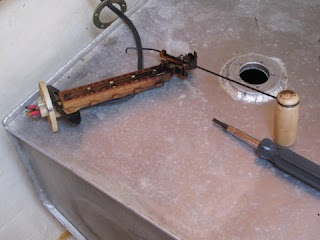 |
| Fuel Sensor Unit |
We checked that the gauge registered properly at both extremes and at the middle of the range by laying the sender on its side, as shown in the photo to the right, then moving the float all the way up (gauge reads full), the middle (gauge reads 1/2), and all the way down (shown here and the gauge reads empty).
We then loosened the keeper screw that holds the wire to the float. Slide the wire in the holder, holding the sender unit next to the tank until the float is near the bottom of the tank while the sender is held next to the tank. This sets the Empty position.
 |
| Adjust Float Wire for Empty |
 |
| Verify Gauge with Float at Full |
It may be necessary to bend the wire a little so that you get full range from Empty with the float near the bottom of the tank, to Full near the top of the tank. When you're happy with the travel range and the reading on the helm gauge, tighten the keeper screw on the wire.
We had several inches of the float wire above the adjusting screw, so we bent the wire so that it would fit into the tank through the mounting hole. Cutting it off will work too, just put a bend in the end so that if the keeper screw ever loosens, the float won't fall off in the tank.
When working on the sensors, we found that the sensor unit screws are not drilled in a symmetric pattern. It is a good idea to scribe a mark on the sensor top and on the tank to indicate its orientation prior to removing it. Otherwise, you get to play an alignment game to determine the position in which all screws will fit into their holes.
Our fuel gauges now read accurately and we can use them to tell when the tanks are full when refilling. More importantly, we know when the tank is near empty!

2 comments:
Is there an application for an ultrasonic fluid level sensor in this type of application? I'd think that no moving parts would be a big win? Though I'm not sure if the effect of sloshing fluid in the take would make it less accurate than a float.
There are quite a few technologies other than a float. As with any sensor, averaging the values over time to yield an accurate reading is important. The sensor we have seems to be accurate and reliable. It wasn't calibrated properly upon installation.
Post a Comment